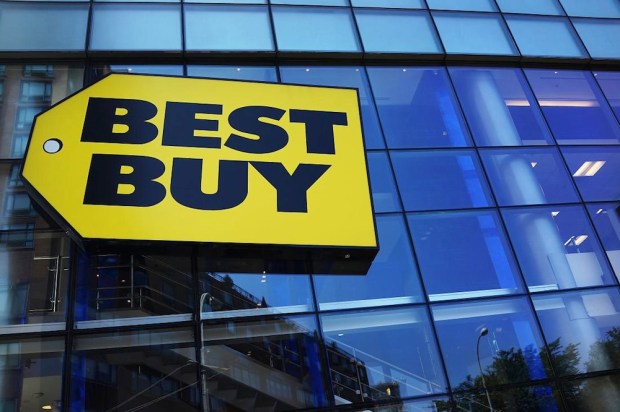Best Buy Beats The Street With Surprise Strength

Best Buy walked into earnings season with a sword or two dangling above its head. The last few quarterly reports have been marked by falling revenue and slipping sales at comparable stores, and Q2 wasn’t exactly one for the books when it came to physical retail. Or maybe it was — but not the books retailers would like to revisit.
In a segment that was weak on the whole, consumer electronics were among the weakest links in the chain. Target took a beating from shareholders after it notched another lackluster earnings performance — a performance that CEO Brian Cornell said was at least partially attributable to weakness in consumer electronics, and particularly Apple products. Walmart, on the other hand, managed to pull off its second quarter of relative strength in a weak field, but even Big Blue reportedly sluggish consumer interest in tablets, TVs and smartphones.
Today it was Best Buy’s turn at the plate. Though many analysts were predicting a rude shock to the other Big Blue’s investors when the results hit today, it seems numbers were better than expected. Revenue was up, and so were same store sales. Investor confidence spiked in early hours trading — the company’s stock priced bounced up 16 percent as Best Buy forecasts end of the year strength that will (slightly) more than counterbalance the rocky start of early 2016.
So how did Best Buy beat The Street, and is the outlook a lot better than it was last week?
By The Numbers
Best Buy had a lot of green arrows to report to its investors this morning when numbers for the second quarter of the year hit the wires. Revenue clocked in at $8.53 billion — about $5 million more than a year ago, beating analysts’ $8.39 billion average estimate. Net income was also on the rise, up to $198 million, or 61 cents per share in Q2 , a notable increase of $164 million, or 46 cents per share, from a year earlier. Profit was 57 cents a share, excluding some items, the Richfield, Minnesota-based company noted Tuesday in a statement, and well in excess of the 43 cents/$8.40 billion average that analysts were predicting.
“We continue to expect the slight revenue decline in the first half to be offset by slight growth in the back half,” Chief Financial Officer Corie Barry noted in a statement that accompanied the earnings release.
Best Buy’s revenue pickup snaps a long cold spell. The firm had seen revenues decline for the previous three quarters before this latest report’s turnaround. The electronics retailer also managed some growth where declines were expected, though in both cases the the numbers were small. Same store sales growth managed to stay in positive territory with 0.8 percent growth — not exactly a barnburner of a number, but a lot better than the 0.6 decline the experts had been looking to see.
The largest U.S. consumer electronics retailer also forecast revenue of $8.8-8.9 billion and a profit of 43-47 cents per share for the third quarter.
Best Buy also managed big growth in its online channels. At 24 percent, it was well ahead of the growth Walmart notched (11.8 percent) and the U.S. average eCommerce growth rate of about 15 percent.
So investors enthusiasm in early hours trading is pretty understandable; Best Buy is notching growth numbers when there was every reason to expect it wouldn’t.
Fighting Gravity
Best Buy’s strength comes at a time and in a segment where competitors online (especially Amazon) and in the physical world (especially Walmart) are coming on particularly strong. Amazon’s Prime Day was a retail even in itself, and it sent a lot of customers to the web looking for brilliant bargains on competitor sites. Best Buy also showed strength in consumer electronics, where its competitors are struggling. Consumer enthusiasm for wearable technology, appliances and home theater gear seemed to more than balance out the relative softness in smartphones and tablets.
CEO Hubert Joly is also widely credited for undertaking an aggressive and organized program to both close underperforming stores and better optimize the retailer’s existing store and warehouse infrastructure.
Charlie O’Shea, an analyst at Moody’s Investors Service, said Best Buy’s online sales growth of 24 percent was “impressive,” and noted that Joly had demonstrated that proper management can make a big difference to the fortunes of struggling retail players.
“[Best Buy’s second-quarter performance] is evidence that a well-managed brick-and-mortar retailer with a well-thought-out strategy that successfully utilizes its physical assets can thrive as it transitions to a true multi-channel retailer,” O’Shea noted.
The fact that Best Buy is managing some legitimate growth in a tough atmosphere raises interesting questions, because Best Buy is not an anomaly. Walmart and TJX are also big-store retailers who are effecting at least something of a turnaround and keeping consumers coming in.
Can Best Buy keep it up? It’s hard to say. The answer is likely dependent on how consumers feel about consumer electronics during the holiday season. But those appliance sales are eye-catching, since they sync up with what Home Depot and Lowe’s are reporting as well.
It’s worth watching to see if Best Buy can keep riding the waves as they come.
